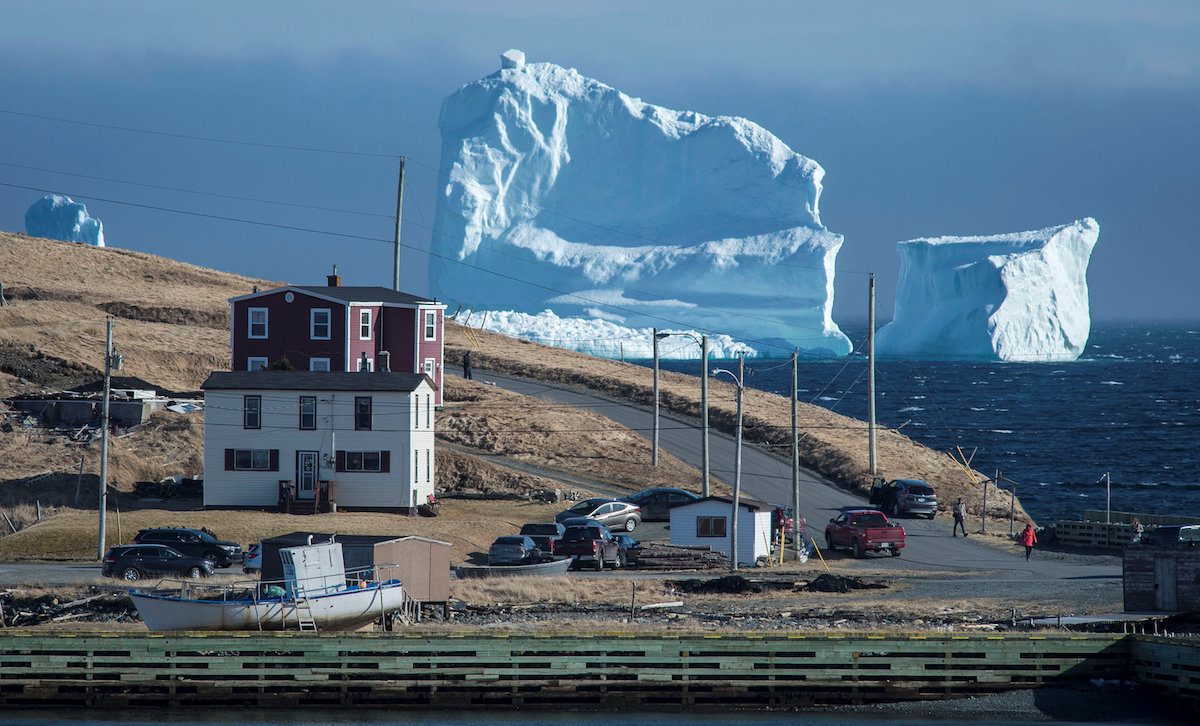Residents view the first iceberg of the season as it passes the South Shore, also known as “Iceberg Alley”, near Ferryland Newfoundland, Canada April 16, 2017. Picture taken April 16, 2017. REUTERS/Greg Locke
By Adam Popescu (Bloomberg) — An island with a 3,893-foot granite mountain juts out of the icy ocean in Greenland’s Karrat Fjord. Beside icebergs the size of football fields lies the seaside village of Uummannaq, which served for centuries as an economic hub until it was abruptly wiped away.
The area has been populated by Inuit people for about 5,000 years and became a Danish municipality in 1763. The village’s population of about 1,200 hauled about 100 metric tonnes of halibut out of the waters each year and catered to Arctic tourists. On the morning of June 17, an Arctic tsunami ravaged Uummannaq and neighboring Nuugaatsiaq. Evidence suggest a climate-induced disaster in which a mountain landslide created 270-foot waves.
“Those waves can travel as fast as a jet engine,” said New York University’s David Holland, who has spent 11 years in the region studying ice-ocean interaction. The wall of water demolished homes, washed boats onto the shore, and left four people dead.°
The Danish government evacuated the town, citing the threat of further tsunamis and landslides. One hundred million kroner, or about $15.7 million, were allocated to move its citizens inland. “People here are traumatized,” said Flemming G. Christiansen, the deputy director general of the Geological Survey of Denmark and Greenland.
Erosion, landslides, and tsunamis are common above the Arctic Circle. It’s a natural consequence of the seasonal expansion and retraction of the ice. As the permafrost melts and waves batter communities, millions are spent annually on beach berms and port defenses in a losing battle to protect the area.
There are no permanent fixes—all human efforts in the region are eventually destroyed by nature. But without the berms and sea walls, the damage caused annually by storms and inclement weather would be far worse.
Protecting these towns isn’t an altruistic ambition. As the Arctic warms, more shipping lanes are opening to the transatlantic shipping industry. It’s a big business. In 2015, $66.9 billion worth of goods were traded between the EU and Canada through the region. Monitoring changes in the great north helps protect this business.
Nearly 1,000 bergs have drifted below 48° north this year, double the average. A cottage industry has sprouted to protect shipping in the area: blasting the ice with water cannons and lassoing it from tug boats to keep it away from oil platforms and ships. But all it takes is one strike to cause massive damage.
Approximately 200 miles south from Uumannaq lies Ilulissat. Sitting at the end of a fjord, the city—whose name means “icebergs” in Inuit—is one of the few places in Greenland where the ice cap reaches the sea. Ice chips off into the water here at a rate of 20 billion tonnes a year. More ice is dumped into the sea here than anywhere else on the planet with the exception of Antarctica. As a result, the area is the source of most Atlantic icebergs. Bergs born here are scooped up by the Labrador Current and carried south, where container ships make enticing floating targets.
“There’s been a lot more ice from Greenland coming into the ocean in the last decade,” says the University of Alaska’s Martin Truffer, who uses ground-based radar to measure glacial movement. “The destructive power of these things is phenomenal.”
Temperature increases mean more landslides, icebergs, and tsunamis. It also means more shipping and a lot more risk. That risk could be mitigated with additional funding sea walls and relocating towns (something already under way in the Alaskan Arctic). But since this polar region is so isolated and poorly represented, it’s an issue few know about and or are willing to pay for.
Christiansen said new settlements will be built according to stricter guidelines, located minimum distances from the shore, and governed by regulations to insure safety. But he sees little hope in stopping more destruction.
“There are huge icebergs everywhere floating along the coast,” said Swiss glaciologist Martin Luethi. “One would have to do maps and calculations of each glacier in each state to see how the danger evolves, but there’s no commercial interest. There’s no awareness of the danger in Greenland. The mindset is s— happens, and that’s it.”
© 2017 Bloomberg L.P

 Join The Club
Join The Club











